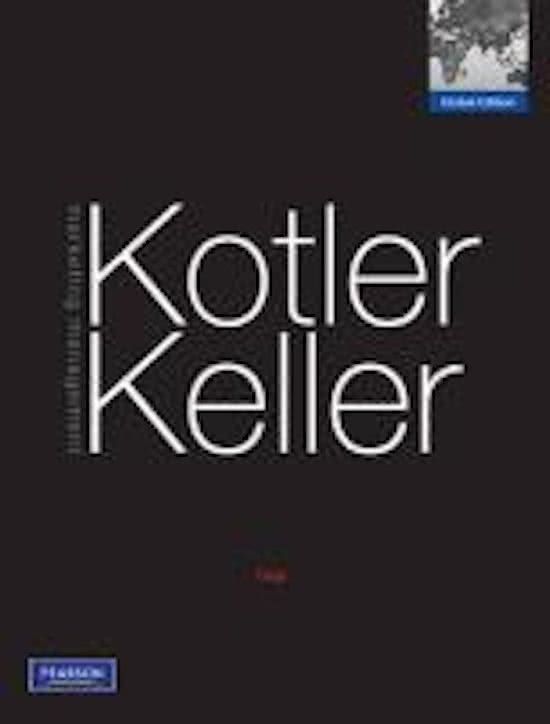Part 5: Shaping the market (offerings)
Chapter 12: Setting product strategy
Discussion questions
- What are the characteristics of a product, and how do marketers classify products?
- Why is product design important and what factors affect a good design?
- How can a company build and manage its product mix and product lines?
- How can companies use packaging, labeling, warranties, and guarantees as marketing tools?
1. Marketing planning
Marketing planning begins with formulating an offering to meet target customers’ needs
or wants. The customer will judge the offering by three basic elements: product features
and quality, services mix and quality, and price (see Figure 12.1).
2. Product characteristics and classifications
Many people think a product is tangible, but a product is anything that can be offered to a market to satisfy a
want or need, including physical goods, services, experiences, events, persons, places, properties,
organizations, information, and ideas.
2.1 Five product levels
Product Levels: The Customer-Value Hierarchy In planning its market offering, the marketer needs to address
five product levels.
Each level adds more customer value, and the five constitute a customer-value hierarchy.
- The fundamental level is the core benefit: the service or benefit the customer is really buying. A hotel
guest is buying rest and sleep. The purchaser of a drill is buying holes. Marketers must see themselves
as benefit providers.
- At the second level, the marketer must turn the core benefit into a basic product. Thus, a hotel room
includes a bed, bathroom, towels, desk, dresser, and closet.
- At the third level, the marketer prepares an expected product, a set of attributes and conditions buyers
normally expect when they purchase this product. Hotel guests minimally expect a clean bed, fresh
towels, working lamps, and a relative degree of quiet.
- At the fourth level, the marketer prepares an augmented product that exceeds customer expectations.
In developed countries, brand positioning and competition take place at this level. In developing and
emerging markets such as India and Brazil, however, competition takes place mostly at the expected
product level.
- At the fifth level stands the potential product, which encompasses all the possible augmentations and
transformations the product or offering might undergo in the future. Here is where companies search
for new ways to satisfy customers and distinguish their offering.
Differentiation arises and competition increasingly occurs based on product augmentation, which also leads
the marketer to look at the user’s total consumption system: the way the user performs the tasks of getting
and using products and related services. Each augmentation adds cost, however, and augmented benefits
soon become expected benefits and necessary points-of parity in the category.
1
,3. Product classifications
Marketers classify products based on durability, tangibility, and use (consumer or industrial). Each type has an
appropriate marketing-mix strategy.
3.1 Durability and tangibility
Products fall into three groups according to durability and tangibility:
1. Nondurable goods are tangible goods normally consumed in one or a few uses, such as beer and shampoo.
Because these goods are purchased frequently, the appropriate strategy is to make them available in many
locations, charge only a small markup, and advertise heavily to induce trial and build preference.
2. Durable goods are tangible goods that normally survive many uses: refrigerators, machine tools, and
clothing. Durable products normally require more personal selling and service, command a higher margin,
and require more seller guarantees.
3. Services are intangible, inseparable, variable, and perishable products that normally require more quality
control, supplier credibility, and adaptability. Examples include haircuts, legal advice, and appliance
repairs.
3.2 Consumer-goods classification
When we classify the vast array of consumer goods based on shopping habits, we distinguish among
convenience, shopping, specialty, and unsought goods. The consumer usually purchases convenience goods
frequently, immediately, and with minimal effort. Examples include soft drinks, soaps, and newspapers.
Staples are convenience goods consumers purchase on a regular basis. A buyer might routinely
purchase Heinz ketchup, Crest toothpaste, and Ritz crackers. Impulse goods are purchased without any
planning or search effort, like candy bars and magazines.
Emergency goods are purchased when a need is urgent umbrellas during a rainstorm, boots and shovels
during the first winter snow. Manufacturers of impulse and emergency goods will place them where
consumers are likely to experience an urge or compelling need to purchase.
Shopping goods are those the consumer characteristically compares on such bases as suitability, quality,
price, and style. Examples include furniture, clothing, and major appliances. Homogeneous shopping goods are
similar in quality but different enough in price to justify shopping comparisons.
Heterogeneous shopping goods differ in product features and services that may be more important
than price. The seller of heterogeneous shopping goods carries a wide assortment to satisfy individual tastes
and trains salespeople to inform and advise customers.
Specialty goods have unique characteristics or brand identification for which enough buyers are willing to
make a special purchasing effort. Specialty goods don’t require comparisons; buyers invest time only to reach
dealers carrying the wanted products. Dealers don’t need convenient locations, although they must let
prospective buyers know where to find them.
Unsought goods are those the consumer does not know about or normally think of buying, such as smoke
detectors. Classic examples of known but unsought goods are life insurance, cemetery plots, and gravestones.
Unsought goods require advertising and personal-selling support.
2
,3.3 Industrial-goods classification
We classify industrial goods in terms of their relative cost and how they enter the production process:
materials and parts, capital items, and supplies and business services. Materials and parts are goods that enter
the manufacturer’s product completely. They fall into two classes: raw materials, and manufactured materials
and parts.
Materials and parts
Raw materials fall into two major groups: farm products (wheat, cotton, livestock, fruits, and vegetables)
and natural products (fish, lumber, crude petroleum, iron ore). Farm products are supplied by many
producers, who turn them over to marketing intermediaries, who provide assembly, grading, storage,
transportation, and selling services. Natural products are limited in supply. They usually have great bulk and
low unit value and must be moved from producer to user. Fewer and larger producers often market them
directly to industrial users. Because users depend on these materials, long-term supply contracts are common.
Manufactured materials and parts fall into two categories: component materials (iron, yarn, cement,
wires) and component parts (small motors, tires, castings). Component materials are usually fabricated further
—pig iron is made into steel, and yarn is woven into cloth. Component parts enter the finished product with
no further change in form, as when small motors are put into vacuum cleaners, and tires are put on
automobiles. Most manufactured materials and parts are sold directly to industrial users.
Capital items
Capital items are long-lasting goods that facilitate developing or managing the finished product. They include
two groups: installations and equipment. Installations consist of buildings (factories, offices) and heavy
equipment (generators, drill presses, mainframe computers, elevators). Installations are major purchases.
They are usually bought directly from the producer, whose sales force includes technical personnel, and a long
negotiation precedes the typical sale. Equipment includes portable factory equipment and tools (hand tools,
lift trucks) and office equipment (personal computers, desks). These types of equipment don’t become part of
a finished product. They have a shorter life than installations but a longer life than operating supplies.
Although some equipment manufacturers sell direct, more often they use intermediaries, because the market
is geographically dispersed, buyers are numerous, and orders are small.
Supplies and business services
Supplies are of two kinds: maintenance and repair items (paint, nails, brooms) and operating supplies
(lubricants, coal, writing paper, pencils). Together, they go under the name of MRO goods. Supplies are the
equivalent of convenience goods; they are usually purchased with minimum effort on a straight-rebuy basis.
Business services include maintenance and repair services (window cleaning, copier repair) and business
advisory services (legal, management consulting, advertising). Maintenance and repair services are usually
supplied under contract by small producers or from the manufacturers of the original equipment.
4. Product and service differentiation
4.1 Product differentiation
Form
Many products can be differentiated in form the size, shape, or physical structure of a product. Consider the
many possible forms of aspirin. Although essentially a commodity, it can be differentiated by dosage size,
shape, color, coating, or action time.
3
, Features
Most products can be offered with varying features that supplement their basic function. A company can
identify and select appropriate new features by surveying recent buyers and then calculating customer value
versus company cost for each potential feature. Marketers should consider how many people want each
feature, how long it would take to introduce it, and whether competitors could easily copy it. To avoid
“feature fatigue,” the company must prioritize features and tell consumers how to use and benefit from them.
Companies must also think in terms of feature bundles or packages. Each company must decide whether to
offer feature customization at a higher cost or a few standard packages at a lower cost.
Customization
Marketers can differentiate products by customizing them. As companies have grown proficient at gathering
information about individual customers and business partners (suppliers, distributors, retailers), and as their
factories are being designed more flexibly, they have increased their ability to individualize market offerings,
messages, and media. Mass customization is the ability of a company to meet each customer’s requirements
to prepare on a mass basis individually designed products, services, programs, and communications. Other
firms have introduced mass customization into other markets.
Performance quality
Most products occupy one of four performance levels: low, average, high, or superior. Performance quality is
the level at which the product’s primary characteristics operate. Quality is increasingly important for
differentiation as companies adopt a value model and provide higher quality for less money. Firms should
design a performance level appropriate to the target market and competition, however, not necessarily the
highest level possible. They must also manage performance quality through time. Continuously improving the
product can produce high returns and market share; failing to do so can have negative consequences.
Conformance quality
Buyers expect a high conformance quality, the degree to which all produced units are identical and meet
promised specifications. A product with low conformance quality will disappoint some buyers.
Durability
Durability, a measure of the product’s expected operating life under natural or stressful conditions, is a valued
attribute for vehicles, kitchen appliances, and other durable goods.
Reliability
Buyers normally will pay a premium for more reliable products. Reliability is a measure of the probability that
a product will not malfunction or fail within a specified time. Maytag has an outstanding reputation for
creating reliable home appliances.
Repairability
Repairability measures the ease of fixing a product when it malfunctions or fails. Ideal repairability would exist
if users could fix the product themselves with little cost in money or time. Some products include a diagnostic
feature that allows service people to correct a problem over the telephone or advise the user how to correct
it.
4





